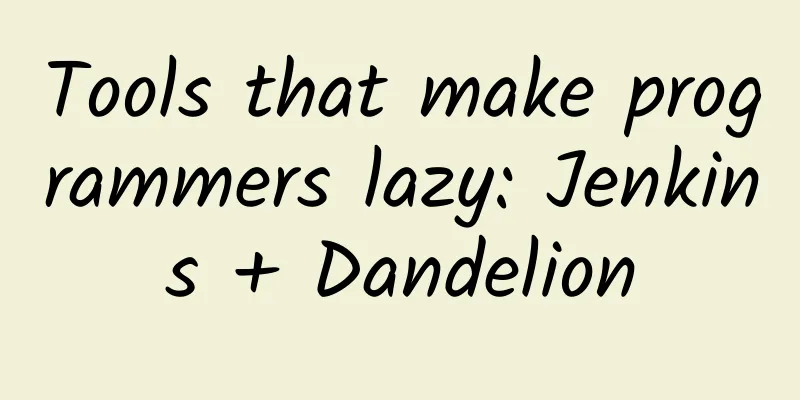Tools that make programmers lazy: Jenkins + Dandelion

|
About laziness I often see many blogs saying that laziness is a good quality of a good programmer. I agree with this because the work of programmers is always full of repetitive work. Perhaps it is for this reason that most programmers gradually become lazy, and those who are not lazy are gradually extinct. As for the word laziness, we should not misinterpret its meaning. It does not mean being lazy and depressed about work, but when a programmer encounters repetitive work, the first thing a lazy programmer thinks of is to develop a tool to automatically perform these tasks. Why do we need tools? When the UI girl gives you a bunch of pictures without adding a @2x suffix, looking at her pitiful eyes, how can you bear to let her redo the work? The lazy programmer will think, this is a repetitive labor, why not write a script to automatically add a @2x suffix to each picture file name, get it done in minutes, and then go home on time for the date... So my first open source tool dSYM analysis tool came from this a long time ago. After I modified several Umeng statistics backgrounds in the command line and collected exceptions, I found that this was a repetitive and tedious work, so I spent more than two hours making an APP application. In this way, all I need to do each time is: 1) open the application, 2) drag in the dSYM file 3) enter the exception address, and I will get the exception information. This article describes how I went step by step from 1) manual packaging -> 2) Jenkins packaging, manual release -> 3) Jenkins packaging + Dandelion distribution. cause The issue of outsourcing is believed to be an indelible pain in the hearts of every programmer, and the test girls also draw a conclusion from every promise made immediately: "You are a big liar." So every time the test girl asked for a test package, the product manager would ask me to install a new version under development, and the backend brother would ask me to install a certain old version of the package to debug it... Then every time I had to pause my work, switch to a certain version, and archive it... Finally, one time I promised the test girl that I would send them a package before dinner, but I was so busy that I forgot about it and went to dinner directly. Seeing all kinds of contemptuous expressions sent by the girl on QQ, this was not the life I wanted. I must change the image of the test girl in my mind, so the matter of automated construction was put on the agenda. Semi-automated with Jenkins I directly chose the mature Jenkins continuous integration solution. As for how to configure it, I won’t go into details. There are many articles about it on the Internet. The most convenient thing about Jenkins is that every time I package, I can directly operate on the company’s Mac server, and I can continue with my work. After packaging, I send the ipa package to the tester. At the same time, I also taught the tester how to download the packaged ipa file from Jenkins. In this way, I can open the Jenkins package on the company’s intranet on my mobile phone at any time. When I told the tester all this, she looked at me with expectation and said, "Is this true..." Jenkins + Dandelion Upgrade I used it for a while and didn't encounter any problems. Maybe I like to tinker. I found that every time Jenkins packaged, I still had to download it manually or let the testers download it. When the testers got the files, they had to connect their phones to the computer and use iTunes or third-party tools to install the files. I thought it would be great if Jenkins would automatically notify the testers to update and install after the package was completed. I had also heard of the third-party distribution platform "Dandelion" before, so I went to the Dandelion website to take a look. I was very happy that they opened APIs for uploading APPs and installing APPs. With this thing, my idea can be fully realized: 1) Jenkins packaging 2) After successful packaging, the IPA file is uploaded to the Tomcat server 3) The IPA file is passed to Dandelion through the API 4) After successful upload, the installation address is sent to the tester by email. 5) The tester directly opens the address on the phone to install. The flowchart looks like this: 1. Upload the IPA file to the Tomcat server Every time Jenkins packages, the compiled files are placed in the build folder under the project root directory. The files in this folder will be overwritten every time a build is performed. Therefore, after each build, I will upload the IPA file to Tomcat via FTP for backup. At the same time, it can also be easily provided to others for download. For example, when sending the installation address of Dandelion to the tester, the IPA download address can also be given. * Open Mac FTP-server Mac computers themselves support FTP services, but the system is turned off by default. The Mountain Tweaks software can easily modify some system settings, such as whether to enable the window opening animation, whether to display the user's Library folder, and one of the options is whether to enable the system's FTP-server function. * Configure Jenkins FTP Server After the Mac server supports FTP-server, I installed the Publish Over FTP Plugin on Jenkins. This plugin can send the specified file to the selected FTP server. After installing the plugin, there will be an additional Publish over FTP setting in the Jenkins system settings. Because Tomcat and Jenkins are on the same computer, the Hostname directly points to the local computer, and the Remote Directory also directly points to the directory of the corresponding app under Tomcat's webapps. After configuration, you can click Test Configuration to test it. If it shows success, it is successful. * Specify the file to upload to FTP in the Job settings After Jenkins has configured the FTP Server, you need to set in the Job which files to upload to the specified FTP Server after the package is successfully packaged. There is a Send build artifacts over FTP option in the post-build operation steps. Here you first need to select the FTP Server we configured before. Source files are all the files in the build folder under our build directory. The Remove prefix is set to build to tell the plug-in not to include build when creating the path. Remote directory is the directory that needs to be created on the specified FTP Server. Here I create a folder with the version number of the Jenkins build, so that when you take the file later, the path will be very convenient to splice. #p# 2. Pass the IPA file to Dandelion through the API After the packaging is successful and the files are backed up to Tomcat, you need to write a script. The script needs to have the following functions: 1) upload the IPA file to Dandelion 2) send an email notification test. These two points can be easily achieved through the script, which has been put on GitHub. If you want to apply the script to your own environment, the most important thing is the following lines of code: uKey, file_name, _api_key, installPassword are configured according to your own situation. The value of project_name is very important and involves many places: 1) There must be a directory corresponding to project_name under the webapps directory of tomcat, because project_name is needed when obtaining ipa_file_tomcat_http_url, and project_name is also needed when obtaining the IPA file sent to Dandelion Next, we need to let Jenkins execute this script. By searching for Jenkins plug-ins, we find a plug-in called Post-Build Script Plug-in. The official introduction of the function is very clear: PostBuildScript makes it possible to execute a set of scripts at the end of the build. After installing this plugin, there will be an additional option of Execute a set of scripts in the Add post-build operation step of the Job. Here I only configured the Execute shell in the Build steps to use the Python compiler to execute the scripts in the project root directory, and checked Execute script only if build success: In this way, when Jenkins is packaged successfully, this script will be executed, and my goal will be achieved. The final email you received might look like this: If you open the email on your mobile phone, you can directly use the third method: click me to install directly. This method is the most convenient, followed by the second method, Dandelion online installation, and the last one is to download the IPA package locally and install it using the tool. Everything you have imagined so far has been realized. From a development perspective, all you need to do during the entire process is click the Build Now button in Jenkins and then continue with the work at hand! Summarize Textbooks regard the ability to make tools as the fundamental difference between humans and animals. I think this is also one of the criteria for judging a good programmer. Excellent programmers will always look for good tools, or create some tools themselves to improve their production efficiency. They use tools to spend the time wasted on repetitive work on more meaningful things. The original purpose of any tool is to improve productivity. Fortunately, there are a large number of pioneers in the iOS development circle. They have created and open-sourced many excellent tools, laying a good foundation for this environment. So at work or in life, create more tools to make yourself lazier, but more valuable! |
<<: Cocos v2.2.1 launches 3D scene editor to challenge the 3D engine market landscape
>>: Don’t Make These Mistakes in Mobile Menu Design
Recommend
Azhe Private Tutor 3.0 "I Know Women's Heart" Full Version
Introduction to Azhe Private Tutor 3.0 "I Kn...
Douyin Local Life Service Merchant Settlement Process and Rules
For merchants operating the [Local Life Services]...
How to get users to try your new product? Here are 5 tips!
A while ago, a new coffee shop opened downstairs ...
YouTube video marketing promotion, how to create video content?
When advertisers use YouTube for overseas video m...
The three laws of traffic products
Why can Waipojia’s Mapo Tofu be sold for as low a...
Case analysis: How to use WeChat fission to attract traffic to offline stores?
Offline "shopping malls" generally enco...
How to attract traffic to hairy crabs on Zhihu?
Get 5000+ customers at 0 cost, how does Daxiex at...
Top 10 Marketing Observations in 2020: Integration of Advertising and Private Domain Traffic
A sudden epidemic in 2020 not only affected every...
Identify the three levels of channel fraud from operational data!
How to judge the quality and cunningness of the c...
What is 404 not found? How to solve 404 not found?
For many novice website builders, when building a...
Xinzhi Short Video Training 0606: Learn to create Douyin film and television accounts in batches in one hour, film and television account creation analysis (with transfer templates)
Currently, the latest lesson on Tongjizhixin is 0...
New Studio - Recording, mixing, dubbing, Baidu cloud download, movie sound processing process
New Studio - Recording, Mixing and Dubbing Resour...
How to open a small store on Douyin without 300,000 followers? Do I need 300,000 followers to open a Douyin store?
Do I need to have 300,000 followers to open a Dou...
"999 Cold Remedy" swept the screen, on the simple role of advertising in user operations
Recently, this advertisement of "999 Cold Re...
"WeChat finally supports multiple devices online at the same time" is on the hot search, but netizens are still dissatisfied: they want more
As a social APP under Tencent with more than 1 bi...









